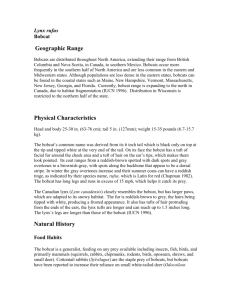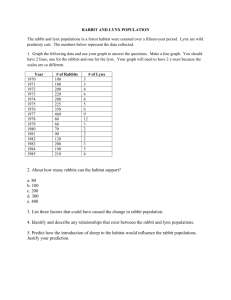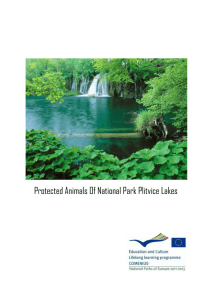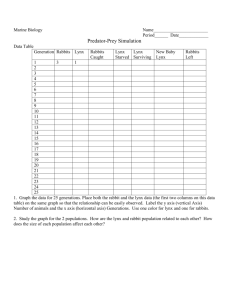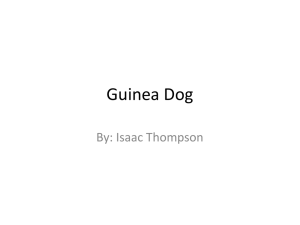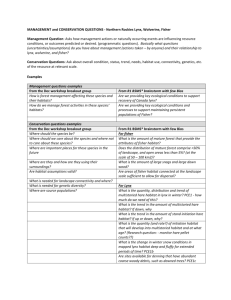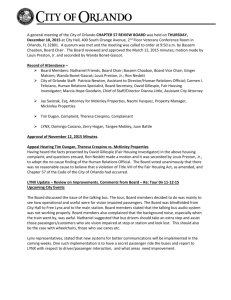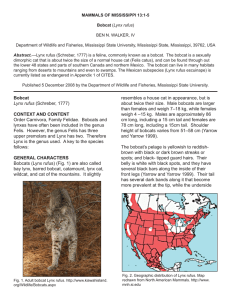Chouljian - York College of Pennsylvania
advertisement
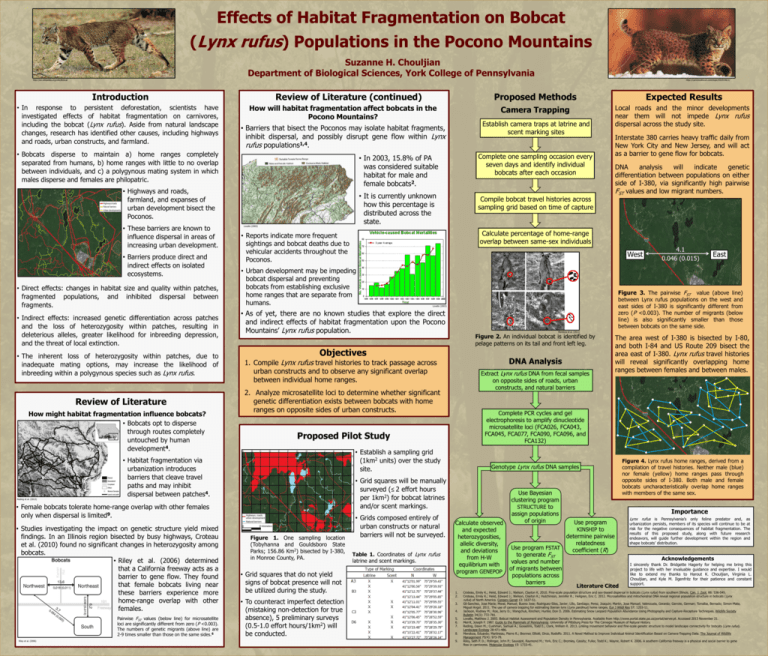
Effects of Habitat Fragmentation on Bobcat (Lynx rufus) Populations in the Pocono Mountains Suzanne H. Chouljian Department of Biological Sciences, York College of Pennsylvania http://en.wikipedia.org/wiki/Bobcat http://carnivoraforum.com/topic/9329146/1/ Introduction • In response to persistent deforestation, scientists have investigated effects of habitat fragmentation on carnivores, including the bobcat (Lynx rufus). Aside from natural landscape changes, research has identified other causes, including highways and roads, urban constructs, and farmland. Review of Literature (continued) How will habitat fragmentation affect bobcats in the Pocono Mountains? • These barriers are known to influence dispersal in areas of increasing urban development. • Barriers produce direct and indirect effects on isolated ecosystems. • Direct effects: changes in habitat size and quality within patches, fragmented populations, and inhibited dispersal between fragments. • Indirect effects: increased genetic differentiation across patches and the loss of heterozygosity within patches, resulting in deleterious alleles, greater likelihood for inbreeding depression, and the threat of local extinction. • The inherent loss of heterozygosity within patches, due to inadequate mating options, may increase the likelihood of inbreeding within a polygynous species such as Lynx rufus. Review of Literature How might habitat fragmentation influence bobcats? • Bobcats opt to disperse through routes completely untouched by human development4. • It is currently unknown how this percentage is distributed across the state. Lovallo (2003) Riley et al. (2006) Lovallo (2003) Figure 2. An individual bobcat is identified by pelage patterns on its tail and front left leg. DNA Analysis Extract Lynx rufus DNA from fecal samples on opposite sides of roads, urban constructs, and natural barriers 2. Analyze microsatellite loci to determine whether significant genetic differentiation exists between bobcats with home ranges on opposite sides of urban constructs. • Establish a sampling grid (1km2 units) over the study site. Genotype Lynx rufus DNA samples • Grid squares will be manually surveyed (≤ 2 effort hours per 1km2) for bobcat latrines and/or scent markings. • Grid squares that do not yield signs of bobcat presence will not be utilized during the study. • To counteract imperfect detection (mistaking non-detection for true absence), 5 preliminary surveys (0.5-1.0 effort hours/1km2) will be conducted. The area west of I-380 is bisected by I-80, and both I-84 and US Route 209 bisect the area east of I-380. Lynx rufus travel histories will reveal significantly overlapping home ranges between females and between males. Complete PCR cycles and gel electrophoresis to amplify dinucleotide microsatellite loci (FCA026, FCA043, FCA045, FCA077, FCA090, FCA096, and FCA132) Proposed Pilot Study Table 1. Coordinates of Lynx rufus latrine and scent markings. East Mendoza et al. (2011) 1. Compile Lynx rufus travel histories to track passage across urban constructs and to observe any significant overlap between individual home ranges. • Grids composed entirely of urban constructs or natural barriers will not be surveyed. 4.1 0.046 (0.015) Figure 3. The pairwise FST value (above line) between Lynx rufus populations on the west and east sides of I-380 is significantly different from zero (P <0.003). The number of migrants (below line) is also significantly smaller than those between bobcats on the same side. Objectives Figure 1. One sampling location (Tobyhanna and Gouldsboro State Parks; 156.86 Km2) bisected by I-380, in Monroe County, PA. DNA analysis will indicate genetic differentiation between populations on either side of I-380, via significantly high pairwise FST values and low migrant numbers. West • As of yet, there are no known studies that explore the direct and indirect effects of habitat fragmentation upon the Pocono Mountains’ Lynx rufus population. • Female bobcats tolerate home-range overlap with other females only when dispersal is limited9. Interstate 380 carries heavy traffic daily from New York City and New Jersey, and will act as a barrier to gene flow for bobcats. Calculate percentage of home-range overlap between same-sex individuals • Urban development may be impeding bobcat dispersal and preventing bobcats from establishing exclusive home ranges that are separate from humans. Reding et al. (2013) Pairwise FST values (below line) for microsatellite loci are significantly different from zero (P <0.003). The numbers of genetic migrants (above line) are 2-9 times smaller than those on the same sides.6 Local roads and the minor developments near them will not impede Lynx rufus dispersal across the study site. Compile bobcat travel histories across sampling grid based on time of capture • Reports indicate more frequent sightings and bobcat deaths due to vehicular accidents throughout the Poconos. • Habitat fragmentation via urbanization introduces barriers that cleave travel paths and may inhibit dispersal between patches4. • Studies investigating the impact on genetic structure yield mixed findings. In an Illinois region bisected by busy highways, Croteau et al. (2010) found no significant changes in heterozygosity among bobcats. • Riley et al. (2006) determined that a California freeway acts as a barrier to gene flow. They found that female bobcats living near these barriers experience more home-range overlap with other females. Camera Trapping Complete one sampling occasion every seven days and identify individual bobcats after each occasion • In 2003, 15.8% of PA was considered suitable habitat for male and female bobcats2. • Highways and roads, farmland, and expanses of urban development bisect the Poconos. Expected Results Establish camera traps at latrine and scent marking sites • Barriers that bisect the Poconos may isolate habitat fragments, inhibit dispersal, and possibly disrupt gene flow within Lynx rufus populations1,4. • Bobcats disperse to maintain a) home ranges completely separated from humans, b) home ranges with little to no overlap between individuals, and c) a polygynous mating system in which males disperse and females are philopatric. Proposed Methods Calculate observed and expected heterozygosities, allelic diversity, and deviations from H-W equilibrium with program GENEPOP 1. 2. 3. 4. 5. 6. 7. 8. 9. Use Bayesian clustering program STRUCTURE to assign populations of origin Use program FSTAT to generate FST values and number of migrants between populations across barriers Figure 4. Lynx rufus home ranges, derived from a compilation of travel histories. Neither male (blue) nor female (yellow) home ranges pass through opposite sides of I-380. Both male and female bobcats uncharacteristically overlap home ranges with members of the same sex. Importance Use program KINSHIP to determine pairwise relatedness coefficient (R) Lynx rufus is Pennsylvania’s only feline predator and, as urbanization persists, members of its species will continue to be at risk for the negative consequences of habitat fragmentation. The results of this proposed study, along with future research endeavors, will guide further development within the region and shape bobcats’ distribution. Acknowledgements Literature Cited I sincerely thank Dr. Bridgette Hagerty for helping me bring this project to life with her invaluable guidance and expertise. I would like to extend my thanks to Harout K. Chouljian, Virginia L. Chouljian, and Kyle M. Ilgenfritz for their patience and constant support. Croteau, Emily K.; Heist, Edward J.; Nielson, Clayton K. 2010. Fine-scale population structure and sex-biased dispersal in bobcats (Lynx rufus) from southern Illinois. Can. J. Zool. 88: 536-545. Croteau, Emily K.; Heist, Edward J.; Nielson, Clayton K.; Hutchinson, Jennifer R.; Hellgren, Eric C. 2012. Microsatellites and mitochondrial DNA reveal regional population structure in bobcats (Lynx rufus) of North America. Conserv Genet 13: 1637-51. Gil-Sanchez, Jose Maria; Moral, Manuel; Bueno Jose; Rodriguez-Siles, Javier; Lillo, Santiago; Perez, Joaquin; Martin, Jose Manuel; Valenzuela, Gerardo; Garrote, German; Torralba, Bernado; Simon-Mata, Miguel Angel. 2011. The use of camera trapping for estimating Iberian lynx (Lynx pardinus) home ranges. Eur J Wildl Res 57: 1203-11. Jackson, Rodney M.; Roe, Jerry D.; Wangchuk, Rinchen; Hunter, Don O. 2006. Estimating Snow Leopard Population Abundance Using Photography and Capture-Recapture Techniques. Wildlife Society Bulletin 34(3): 772-781. Lovallo, Matthew J. 2003. Bobcat Habitat Assessment and Population Density in Pennsylvania. Available from http://www.portal.state.pa.us/portal/server.pt. Accessed 2013 November 21. Merrit, Joseph F. 1987. Guide to the Mammals of Pennsylvania. University of Pittsburg Press for The Carnegie Museum of Natural History. Reding, Dawn M.; Cushman, Samuel A.; Gosselink, Todd E.; Clark, William R. 2013. Linking movement behavior and fine-scale genetic structure to model landscape connectivity for bobcats (Lynx rufus). Landscape Ecology 28:471-486. Mendoza, Eduardo; Martineau, Pierre R.; Brenner, Elliott; Dirzo, Rodolfo. 2011. A Novel Method to Improve Individual Animal Identification Based on Camera-Trapping Data. The Journal of Wildlife Management 75(4): 973-79. Riley, Seth P. D.; Pollinger, John P.; Sauvajot, Raymond M.; York, Eric C.; Bromley, Cassity; Fuller, Todd K.; Wayne, Robert K. 2006. A southern California freeway is a physical and social barrier to gene flow in carnivores. Molecular Ecology 15: 1733-41.
